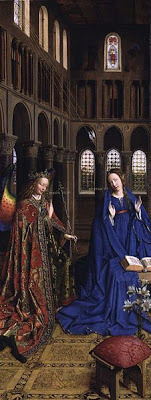Moving the Annunciation
 Because today is Fig Monday/Monday of Holy Week, the Feast of the Annunciation of Our Lord has been moved this year to the Monday after the Easter Octave/Divine Mercy Sunday. Nevertheless, this article by Richard Cork in The Wall Street Journal about Jan van Eyck's painting of the Annunciation seems worthy of mention today:
Because today is Fig Monday/Monday of Holy Week, the Feast of the Annunciation of Our Lord has been moved this year to the Monday after the Easter Octave/Divine Mercy Sunday. Nevertheless, this article by Richard Cork in The Wall Street Journal about Jan van Eyck's painting of the Annunciation seems worthy of mention today:Nothing in the Bible story is more astounding than the pivotal instant when, quite suddenly, the Virgin Mary receives an unexpected visitor. Brandishing a resplendent pair of wings, the Angel Gabriel descends from heaven and gives the young woman some shocking news: She will conceive and give birth to Jesus, the Son of God.
In December last year, I posted about the exhibition of works by Van Eyck and others in Rotterdam. Cork concludes his WSJ article with some comments about the presence of this painting in the National Gallery of Art in DC: Nearly five centuries after it was painted, "The Annunciation" became the focus of a battle between the Hermitage Museum in St. Petersburg and an obsessive American multimillionaire. In June 1930, Hermitage officials were appalled by Stalin's decision to sell key paintings in its collection to wealthy foreign collectors. But Andrew Mellon, the U.S. secretary of the Treasury, bought "The Annunciation" with 20 other Hermitage paintings before locking them away in a basement near his Washington home. And in 1935, after the U.S. government brought tax-evasion charges against him, Mellon suddenly announced that he would found a great gallery in the capital. Richard Cork is the author of The Healing Presence of Art: A History of Western Art in Hospitals from Yale University Press: Between birth and death, many of life's most critical moments occur in hospital, and they deserve to take place in surroundings that match their significance. In this spirit, from the early Renaissance through to the modern period, artists have made immensely powerful work in hospitals across the western world, enhancing the environments where patients and medical staff strive towards better health. Distinguished art historian Richard Cork became fascinated by the extraordinary richness of art produced in hospitals, encompassing work by many of the great masters - Piero della Francesca, Rogier van der Weyden, El Greco, William Hogarth, Jacques-Louis David, Vincent van Gogh, Frida Kahlo and Diego Rivera, Fernand Leger, Marc Chagall and Naum Gabo. Cork's brilliant survey discovers the astonishing variety of images found in medical settings, ranging from dramatic confrontations with suffering (Matthias Grunewald at Isenheim) to the most sublime celebrations of heavenly ecstasy (Giovanni Battista Tiepolo in Venice). In the process, he reveals art's prodigious ability to humanize our hospitals, alleviate their clinical bleakness and leave a profound, lasting impression on patients, staff and visitors.
Published on March 24, 2013 22:00
No comments have been added yet.



